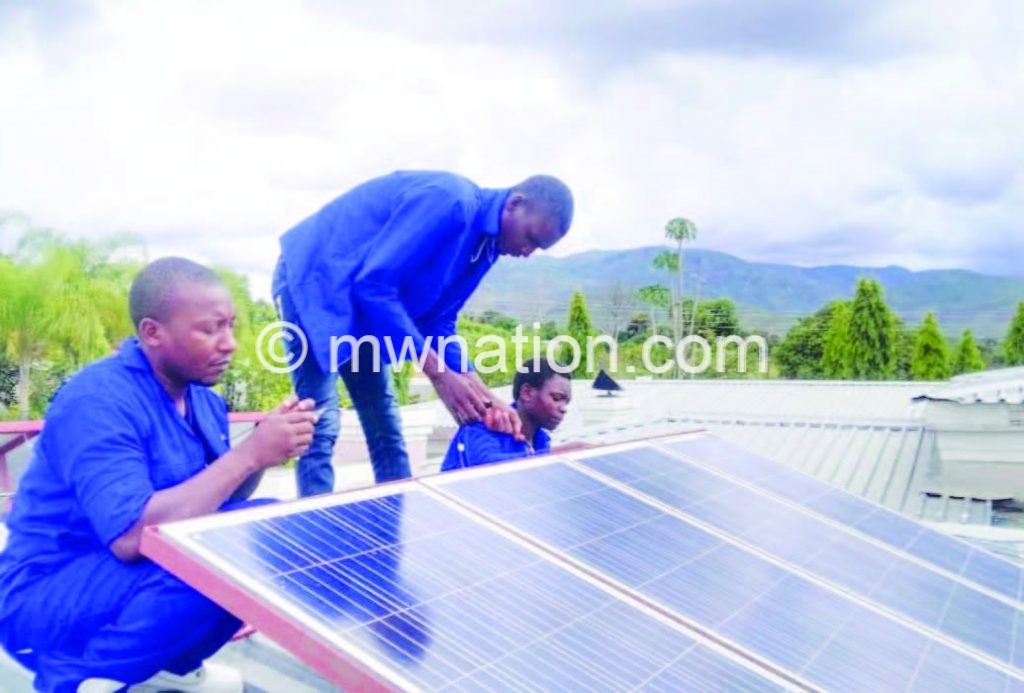Boy who defied energy law
Many scientists grow up memorising time-honoured laws that energy can neither be created nor destroyed, but only transformed from one form to another.
However, Benedict Kankulungo, 25, is changing the age-old law of energy transformation using a homemade unified solar-energy system.

The brainchild of the young man from Kamanjere Village, Traditional Authority Sitola in Machinga more than doubles solar energy, reducing the cost of electrifying “dark spots” excluded from grid power.
Speaking at the opening of Chinduzi Health Post in Machinga, Kankulungo, a secondary school dropout, said his invention triples the power output passing through it. The health centre has been electrified by the innovator’s Clean Energy Engineering with support worth K5.5million from World Connect.
He narrated his humble beginnings: “I started investigating the unified system by accident in 2013 when wind blew off a solar panel of a certain rich man in my village. While the man was crying for the damaged panels, it was an opportunity for me to study the solar pieces we salvaged.
“I wanted to boost the low energy output from the broken solar panel for home use at an affordable cost.”
Kankulungo’s village is not electrified, a common inequality in Malawi where 90 percent of the population has no access to electricity. The gap is wider in rural areas, where only four percent have access 40 years since Electricity Supply Corporation of Malawi launched the Rural Electrification Programme, now run by the Department of Energy Affairs.
The only sources of energy for lighting in Kankulungo’s rural locality are kerosene lamps, candles and torches powered by costly dry cells.
This motivated him to explore innovations likely to close the energy gap.
He explains: “Reading Thom Duncan’s book deflated my ego. Since both heat and work can be measured, it is like saying that any change in the energy of a system results in a corresponding change in the energy of the surroundings of the system. In other words energy cannot be created or destroyed.
“The common principle shows that when energy is passed through a conductor, some energy is lost on the way. So, the input isn’t equal to the output. However, that only energised me to work hard and not accept energy laws as gospel truth.”
Kankulungo, the technical director of his own Clean Energy Engineering, rolled out the first usable system in 2016.
Saidi Banda, spokesperson of the Ministry of Energy, says the unified solar energy system is the first of its kind, defying the energy transformation rule.
“I can confirm that this is the first time anybody anywhere in the world has created a technology that can boost energy output. As a ministry responsible for energy, we have never seen or heard of any technology capable of increasing energy like this system,” he says.
Banda says Kankhulungo’s technology has potential to reduce cost of clean energy in the country.
The ministry is assisting Clean Energy Engineering in patenting the innovation.
Bright Msaka, member of Parliament for Machinga Likwenu, is dazzled by the innovation powering the health post.
He finds the new solar power system “extremely fascinating” as it transforms direct current to alternative current while stepping up power output.
“The clinic uses one solar panel instead of four, which is extraordinary in terms of cutting the costs of electrification. We need to draw sufficient interest in the innovation in promoting this technology from which Malawi can immensely benefit,” he says.
World Connect country director Frank Kasonga assisted Clean Energy Engineering to construct the health post for his community.
He says his organisation will keep working with young Malawians to come up with low-cost projects that can transform their communities.
“Clean Energy Engineering has provided the energy for lighting the health post with only one panel in a situation where four panels would have been needed. This is an innovation which should be encouraged to transform the energy sector in the country,” said Kankulungo.
He says his system is fully self-protected because it automatically shuts down when there is a fault or overload.





